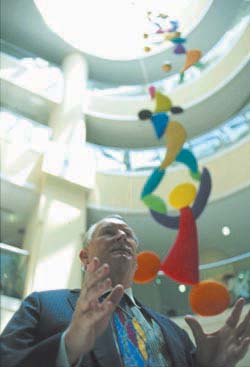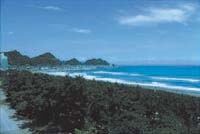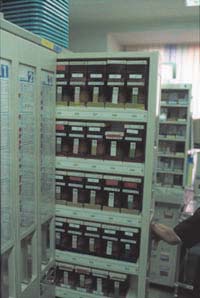Japan's Medical Revolutionary
Back to Contents of Issue: September 2002
|
|
|
|
by Bruce Rutledge with special reports by Jasmine Pui and Craig Mod. |
|
 HERE'S HOW TO GET smack into the middle of Japan's health-care debate: Ride an express train from Tokyo Station two hours to the southern end of Chiba's Boso Peninsula, get off at the sleepy little station of Awa-Kamogawa, hop in one of the taxis waiting for tourists, ride down a long winding road, past the 'viking' buffet at the Sea World Hotel, past the Sea World park itself and finally to a heliport next to a rocky beach; turn left at the heliport and you've arrived at Kameda Medical Center. HERE'S HOW TO GET smack into the middle of Japan's health-care debate: Ride an express train from Tokyo Station two hours to the southern end of Chiba's Boso Peninsula, get off at the sleepy little station of Awa-Kamogawa, hop in one of the taxis waiting for tourists, ride down a long winding road, past the 'viking' buffet at the Sea World Hotel, past the Sea World park itself and finally to a heliport next to a rocky beach; turn left at the heliport and you've arrived at Kameda Medical Center.One of the most provocative arguments for more competition in Japan's health-care system sits a stone's throw away from the craggy coast of Chiba prefecture. Kameda has been a family-run hospital for more than 350 years, but lately the complex of 11 buildings has started to turn heads around the world for its cutting-edge approach to hospital care. Its electronic medical records system has turned Kameda into a paperless hospital (see Cradle to Grave -- Your Life on a Chip, page 21), its telemedicine services are the digital age's version of a house call (elderly people can be diagnosed from home by specialists even if those doctors aren't at Kameda) and its sun-splashed lobby, staff trained by Japan Airlines and frequently changing art displays are everything that socialized medicine is not. Movie stars, political figures and other 'VIPs' can check into the hospital via a private entrance off the parking lot, then be whisked up to the sixth floor where private rooms with no names on the door, splendid ocean views and mini-bars full of fresh juice await. There are steam baths, a Jacuzzi, a fully equipped gym and private restaurants. "It feels like we're in Waikiki," says one young man strolling through the gym. But Kameda is no elitist hideaway. The hospital treats about 2,500 outpatients a day. On one sultry summer morning, the lobby was packed with patients, family members and friends. By 1:10 pm the cashier's computer terminal showed that 2,137 patients had shown up that day and 1,268 had already been treated and released. Kameda may be tucked into a remote corner of the Kanto region, but it is a leader in promoting the idea that you should consider crossing prefectural lines to get the best medical care. "I wish we were in Tokyo," says John Wocher, executive vice president of administration at Kameda. Why? Because then more people would know what is possible and begin to demand more out of their hospitals, he says. "Where would you go if cost wasn't a factor? Patients for some reason tend to think that bigger is better or they pick the hospital closest to their home."  World-class care
World-class careWocher is the man behind much of the change at Kameda. He is also the author of the book Nippon no Byoin: Naze Nihon no Byoin wa Dame Nanoka (Japan's Hospitals: Why They Are Bad), published by Nikkei BP in October 2000. Wocher is introducing Japan to a different approach to health care, something more akin to the Mayo Clinic in the US or the Cleveland Clinic, near his hometown of Avon Lake, Ohio. At the Cleveland Clinic, for example, rich patients regularly fly in from the Middle East for treatment. Clevelanders talk of glimpsing harems at the local shopping mall or the hotel connected to the clinic. But in Japan, crossing prefectural lines to get medical care is rare, and while some cross national lines for transplant surgery and other operations that are taboo in Japan, there is little pull to make Japan a place with hospitals that draw patients from overseas. Wocher is looking to open that market and make Kameda a hospital that draws people from all over the world. Today Kameda is considered one of Japan's best hospitals; it was ranked No. 4 in the nation by Nikkei Business in an August 2001 poll and No. 3 in terms of information disclosure. Wocher boasts that "my friends who are CEOs in the States come out here for their physicals" although he refused to divulge any names. Wocher is a military man with a long career in Japan. He first came to Japan in the year Tokyo hosted the Olympics. "It was 1964 and I was a wide-eyed 20 year old. I climbed Mount Fuji," Wocher recalls. (For another take on climbing Fuji-san and traditional Japanese hospitals, see The Other Side of the Coin below). He retired from the navy as a lieutenant commander in the medical service corps, but he is not a medical doctor -- he's a trained health care administrator, a title that is all but unknown in Japan, where medical doctors run the hospitals. Wocher met the Kameda family through his work at the US naval base in Yokosuka in the early 1980s. The family was looking to tie up with a hospital with a heliport to refer patients and they visited Yokosuka several times. The Kamedas and Wocher struck up a relationship and in 1991 they decided to join forces. "They were looking to take on the necessary evils -- quality improvement, risk management -- and they didn't want to do it in 100 years, they wanted to do it in three or four," Wocher says of the family. Today Dr. Toshitada Kameda is the center's chairman of the board.  New approach
New approachIn April 1995, the new Kameda hospital opened and it was immediately apparent that the Kamedas had struck on something new. Patients walk into a sunlit atrium when they enter the hospital; they are greeted by hostesses trained by Japan Airlines. Even Wocher underwent the 16-hour training: "Feet at a 45-degree angle, bow 45 degrees. Smile, say 'whiskey'." But there was more than just flash and good design behind the new and improved Kameda hospital. "We were trying to say to people that a hospital doesn't have to be institutional," Wocher says. "We want to be world class -- not just the best Japanese hospital." So what sets Kameda apart? "There are things here that could be used as benchmarks in the States," says Eric Bloom, an intern at Kameda from the University of Iowa. "The EMR system, for example, could be used as a benchmark." Kameda also has a nursing school attached to it, guaranteeing a fresh supply of nurses familiar with the Kameda approach. Wocher himself takes 80 of these nurses abroad every year to visit some of the best hospitals in the world. And there are quirky little things throughout the hospital that give it its personality. The center uses a pneumatic tube system to send messages and samples throughout its buildings. "It can shoot the tubes up to 5km, so we were thinking we could send it to local pharmacies," Wocher says. Also, tucked away on the sixth floor is a saddle and mount for injured jockeys to practice on. "They come up here in full uniform, with their riding crops," he says. But perhaps most importantly, there is a markedly different approach toward patients here. For example, when patients are admitted to Kameda, they are given a package of information that recommends they get a second opinion, something that is not common practice in Japan. Also, if an individual wants to know about his or her condition, but the family wants to shield the patient from that knowledge, Kameda will "always side with the individual patient," Wocher says. In a hospital system where "don't ask, don't tell" prevails, this is a marked difference. Surprisingly, Wocher says he faced little resistance instituting all these changes. "Instead of improving two things 50 percent, we improve 50 things 2 percent," says Wocher, who has a penchant for slogans -- "We can't just satisfy the patients, we have to delight them" is one of his favorites, as is this critique of the Japanese medical system: "If you're wrong the first time and right the second, you get reimbursed twice." Competitive medical care But is a more competitive, free market approach to health care really what the Japanese want? Do they really want to go down the road of the US, where the rich get the best care and the rest get by? Isn't a private hospital like Kameda more for the rich, who can afford private rooms with no names? Wocher takes issue with the idea that Japan's system is inexpensive and thus more egalitarian. "You think it's cheap, but what do you get for that premium? You have no choice in coverage because it's a monopoly provider, it doesn't include daily food charges, new technology is often not approved, you have to rent the TV and there's no same-day surgery," he says. Wocher points to Kameda's physicals as a case in point. The half-day physical costs \30,000, which is on par with fees at other Japanese hospitals. Kameda's \30,000 physical is more specialized, however, concentrating on the brain. Perhaps Kameda will end up serving as an example of what's possible while not really affecting the national scene. Its easy access to Narita airport on the other side of the prefecture means patients could fly in from anywhere and head to Kameda without even going through Tokyo. But is the Kameda experiment destined to remain a diamond among the rough? Or is Wocher going to put Kameda in the national spotlight to force debate about Japan's medical system? Wocher is ready for the debate -- he's no shrinking violet. He's appeared on TV with Beat Takeshi discussing second opinions, and when Nikkei BP published his book in the fall of 2000, he typed up a letter to health minister Yuji Tsushima and taped it into the book. The letter offered 10 suggestions on how to make an impact on health care "with the stroke of a pen." The suggestions include: * Making a law that bans smoking in health-care facilities * Making smokers pay higher premiums than nonsmokers * Giving patients unrestricted access to their personal files * Stopping the practice of licensing physicians for life * Promoting continuing education for doctors How many of his ideas were adopted? "None," Wocher says, but he doesn't seem all that dismayed as he says it. He's too busy to mope. He has blocked off two-and-a-half hours to show off the Kameda facilities to a couple of reporters. Little by little, he's getting the word out that down in southern Chiba there's a medical revolution going on. And, heck, even if the folks in Kasumigaseki don't listen to his ideas, he's having a lot of fun in sleepy Awa-Kamogawa. "If I could move the building just 25 yards, I could fish from the office," he says. @ |
|
Note: The function "email this page" is currently not supported for this page.





